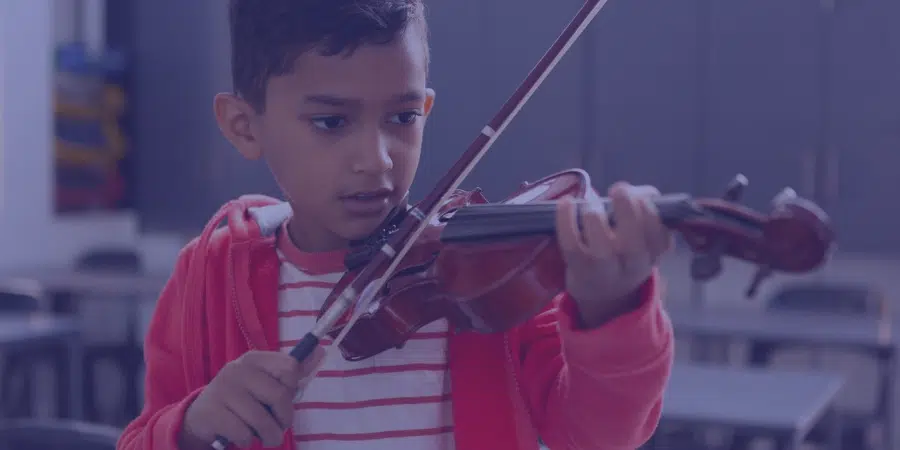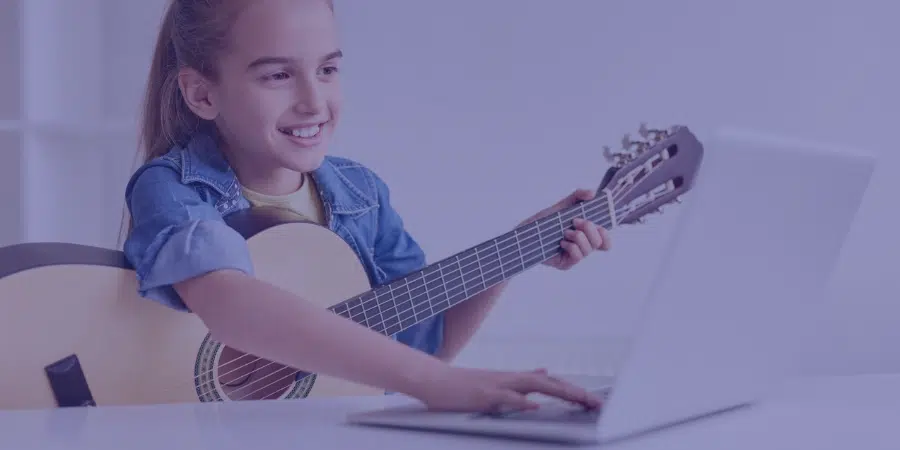Teaching music remotely allows you to bring in new modes of collaboration to your music studio, while also providing flexibility for your teachers and students. If you’re ready to start offering online music lessons, these are our tips to make that happen. We cover best practices for video lessons, tools that can help out, and more.
Teaching Music Remotely: The Basics
The community aspect of learning is undeniably one of the bonuses of in-person classes. Setting your chair next to a good friend or exploring new styles in an intimate quartet are hallmarks of traditional music instruction.
However, there is also no denying the bountiful benefits of teaching music remotely.
For people who have struggled to find the time or transportation to attend classes, remote music lessons are a great solution. A virtual music classroom also guarantees that class is regularly in session, regardless of weather. For serious music students, this means no skipped instruction or downtime.
Other benefits of teaching music remotely include:
- The ability to incorporate online music games for students of all ages
- Opportunities to play with or learn from musicians across the globe
- Chances to incorporate online music theory instruction
- Limitless creative possibilities made possible with technology
That flexibility goes further. You can transition some or all of your students to online music classes. Choose to host specific classes online—like adult learning classes—and keep others in the studio. Or, work with your student’s schedules by offering online classes during summers.
No matter how you offer online classes, making the switch is well worth it. Here’s how to get started.
1. Set the tone
Just as you decided on a format and a schedule for in-person instruction, you’ll need to decide on a format for remote learning music lessons.
This step will cover some of the practical aspects discussed below, but also your online teaching style, what you expect from students, and more. By setting the tone from the start, your students will know what to expect whenever they log in.
2. Choose a class platform
Your class platform is how you will actually interact with students virtually. You have many different options.
- Zoom: Free options, with easy operation and features like chat
- FaceTime: Great for individual instruction for iOS users
- Google Meet: Free and easy to use for groups
Zoom is one of the most popular video conferencing tools. If you’re already a Studio Director customer, we offer a Zoom discount and can also help you get up and running with this option.
Note that Facebook Messenger and WhatsApp can also be utilized but may not be as functional.
3. Work with (not against!) time
Latency is the lag that occurs in even the best interactive platforms with the fastest internet connections. If you are working with soloists or individual distance learning music activities, latency is not a problem, but for choral groups or bands, this can make teaching music remotely challenging.
For coordinated group instruction, investigate low- or ultra low-latency software options. There aren’t many options for individual instructors, but JackTrip is one way to combat the lag. For small- or large-group performances, video editing may be your best friend (see below).
4. Get the right equipment
Set yourself (and your students) up for success by getting the right equipment from the start.
Most laptops come with a decent webcam and speaker, but students might need to purchase other equipment for their use at home (e.g., metronomes, sheet music, and headphones).
5. Set up online registration and payments
You’ll be teaching online, so your systems need to be online too.
Find a music management software that allows you to register students, schedule their lessons, and collect online payment as part of your plan for remote learning music lessons. Once that’s in place, make sure your students have online payment options. It can be difficult to manage paper payments when teaching virtual classes. The best way to ensure you are paid promptly is to allow students to pay with card. Collecting debit and credit card payments is convenient for you and students. Additionally, you may want to offer recurring billing options so students (or their parents) can set it and forget it!
6. Stay on key
Yes, you can point the camera at yourself and hit “join meeting” to get started, but there are best practices that can help make teaching music remotely more successful.
Using proper lighting so that students can see your face and your movements on the instrument is key, as is muting participants when chatting is not helpful. Set your space up so that students have a clear view of any materials you need them to see.
Also consider things like:
- When will questions be allowed, and how should they be asked?
- Will there be time for groups to chat before, during, or after class?
- Can students personalize their screens with a background?
- Who will mute participants when background noise (pets, other children, etc) become a nuisance?
Best practices for online video conferencing means that everyone has the highest quality experience possible.
7. Direct their attention
Crucial in these rules is explaining to students what you would like them to focus on. Many students treat video conferencing as a mirror and keep their eyes on themselves (you can watch this happen as they make faces and check their hair).
If you want them to focus on you, direct their attention.
8. Accent the positive
Likewise, it can be an adjustment, but as with in-person music instruction, remote learning music lessons only work if everyone follows a set of rules. Make it easy on yourself by laying those out ahead of time.
You might consider rules surrounding starting and ending times, eating during instruction, and distractions in the student’s home. While it may seem obvious that students need a quiet space to focus on their lesson, make sure students understand the expectation of no barking dogs and no television in the background.
Like regular classes, phones should be put away and on silent unless you’re using them in your instruction.
9. Use apps for music teachers
Speaking of, go fully digital with apps built for music teachers and students. We explored some of the best options in our best apps for music teachers post, with options that help with:
- Management, like registration and billing
- Ear training and metronomes
- Musical theory and sight reading
- Music composition
10. Play on: Develop a plan for practice
Especially for younger students, set a practice plan after each lesson, with concrete notes that include:
- Which days they will practice
- How long each practice session will last
- Any goals for their practice
This keeps students on track and ready for their next lesson.
11. Explore new modes of instruction and collaboration
Technology and teaching music remotely makes new and experimental modes of instruction and collaboration possible. This includes using editing software to bring large and complicated orchestral performances together as well as inviting guest teachers and musicians to add value to your sessions.
For example, consider this performance from the musical Hamilton. Collaboration and coordination are possible online in new ways and can result in beautiful music.
Make Teaching Music Remotely Easier
If you are considering teaching music remotely, the last thing you want to do is spend time managing the administrative aspects of it. Let The Studio Director help you set up online registration and payments to make online classes even easier.
Get in touch today to get started or to set up a free trial!




